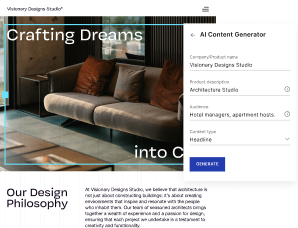Carousel ads allow advertisers to showcase multiple images in a single ad, hence improving the likelihood of a conversion. LinkedIn Carousel ads are no different — they help you tell a story with your ads, get brand recognition, and increase your advertising ROI.
Let’s dig a little deeper into what LinkedIn Carousel ads entail.
What are LinkedIn Carousel Ads?
LinkedIn Carousel ads are one form of Sponsored Content that feature a swipeable series of cards. You can showcase multiple offers/products which helps you provide more insights for your audience.
These ads appear natively in the news feed, on your LinkedIn Page and in the news feed of your followers across all devices and platforms, mobile too.
A typical LinkedIn Carousel ad features multiple image cards and every card has a headline and intro text:
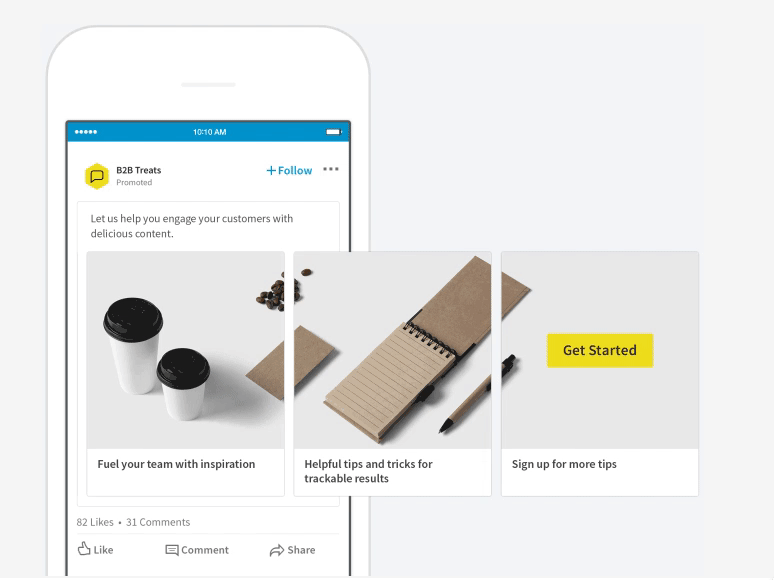
You can create Carousel ads for two campaign objectives, brand awareness, brand consideration, and conversions. Depending on the campaign objective you have set you can either:
- Send people to your landing page
- Collect leads using LinkedIn Lead Gen Form
VMware Cloud’s carousel ad collects leads via a Lead Gen Form:
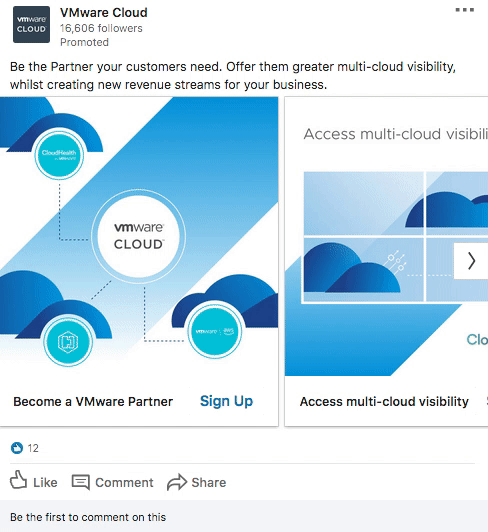
In addition to all the standard advertising metrics, such as CTR and number of leads, carousel ads on LinkedIn also give advertisers access to the number of impressions and clicks for each card. This insight helps you refine ads until you find the perfect way to present the story of your brand.
Carousel ads offer you three things that other LinkedIn ad formats don’t:
- Better storytelling: you can tell a story with each card and make your ad more personalized for your audience. The ad type showcases your brand’s personality and helps you connect with the audience.
- Promoting more content in one ad unit: Contrary to other ad formats that limit you to one piece of creative, carousel ads promote up to 10 images/cards. By having 10 images, additional CTAs, and the possibility to have each card go to a unique landing page, you give your audience a complete picture of what the offer is all about.
- Higher CTRs: Out of over 300 advertisers who beta-tested carousel ads for Sponsored Content, 75% claimed to use the ads in their next content campaign, because they saw a lift in engagement and click-throughs compared to other standard Sponsored Content campaigns. This is because carousels have more content, which gives advertisers multiple opportunities to entice users to click through and evaluate the offer on the landing page.
Whether you’re a financial enterprise or a SaaS company you can use the ad format to promote your offers to your target audience.
Now that we have detailed the campaign objectives and demonstrated how unique the ad type is let’s outline the ad specs.
Ad specs for Carousel Ads
Before you create carousel ads, there are two prerequisites. You must be:
- A LinkedIn Page admin with user access to the Campaign Manager tool and have permissions higher than Viewer
- Granted permission to post Direct Sponsored Content
If you satisfy both requirements, these are the ad specs to reference:
- You must have a minimum of two cards and no more than 10 cards.
- For the overall ad unit, the intro text/commentary/description area is limited to a maximum of 255 characters.
- Intro text may truncate at 150 characters on some mobile devices.
For the individual cards within the carousel:
- Max file size: 10 MB
- Recommended individual image spec: 1080×1080 pixels with a 1:1 aspect ratio
Rich media formats supported:
- JPG
- PNG
- GIF (non-animated only)
Headline text for each image card is a maximum of two lines before being truncated:
- 45-character limit for carousel ads that direct to a landing page
- 30-character limit for carousel ads with a Lead Gen Form CTA
Video format is currently not available for the ad format. Ads that use Lead Gen Forms include a CTA button in each image card. However, standard carousel ads on LinkedIn that take visitors to a landing page don’t include a CTA button:
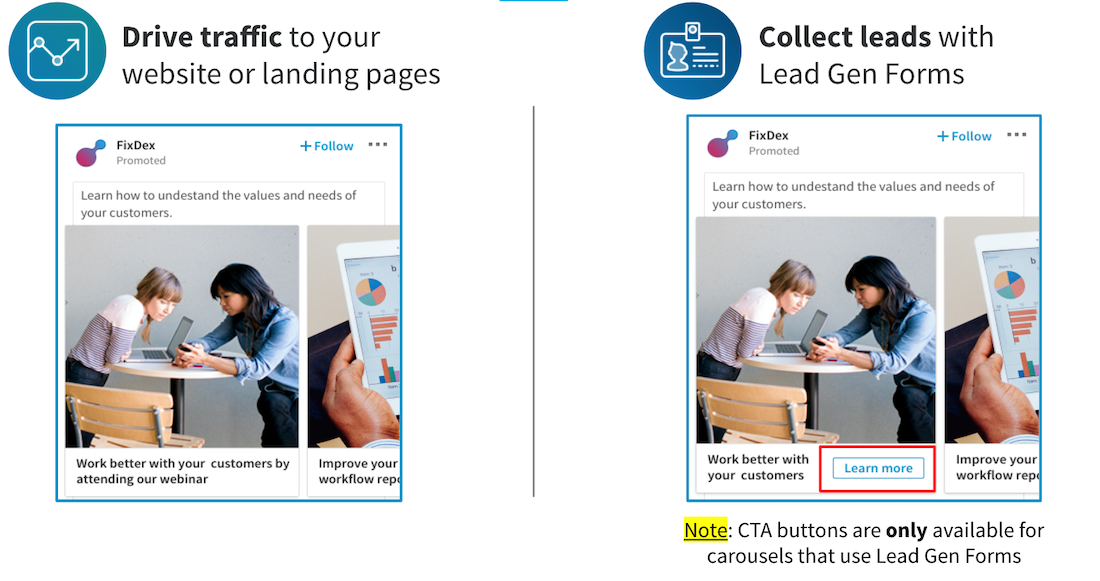
Once you know what the ad format deems permissible, you can create your carousel ads following these steps.
How to create Carousel Ads
1. Sign into LinkedIn’s campaign manager
2. Select create campaign
3. Select your objective. LinkedIn has a few available right now: website visits, engagement, video views, and lead generation
4. Give your campaign a name
5. Once you select your objective, choose the profile language, locations to target your ad, and select your target audience. (Create your own audience, retarget users who visited your site, or upload a list of users to target).
6. Select your ad format. In this case, you’ll select carousel image ad:
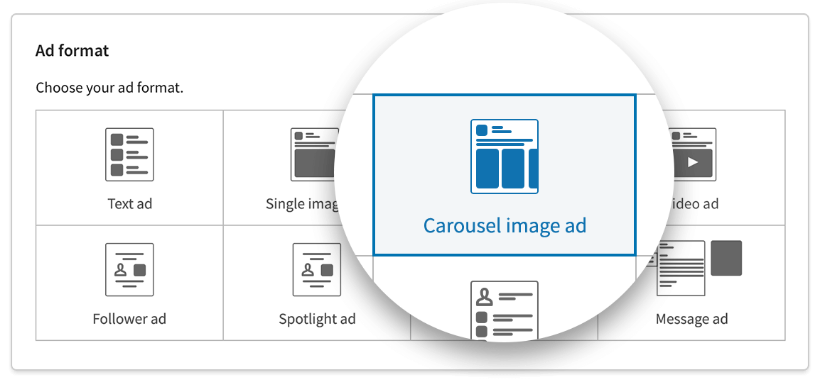
7. Select your budget, schedule, bid type, and bid amount
8. Add conversion tracking (optional, but recommended)
9. Click save and next
10. Select create new ad from the top right corner, or select browse existing content if you have any carousel content that you ran in the past.
11. When you click create a new ad, enter the ad name, the intro text (255 characters max, truncates at ~150 characters on mobile), the destination URL, and create your cards
12. Click create and you’re done.
As you go through the setup process, keep these best practices in mind so your ads make a good impression on your target audience.
Best practices when creating ads
Here are some techniques you can use to optimize your ads:
- Write descriptive ad headlines and copy so your audience understands the message.
- Feature a clear CTA so the audience knows what they’ll be getting next.
- Be specific with ad targeting, but not too specific that you narrow the audience. Choose location and two other targeting criteria when starting out, and then follow these ad targeting best practices.
- Include clear messages and calls-to-action on each carousel card description.
- Leverage existing content by combining it with content that has a similar theme, or deconstruct a large piece of content into carousel cards.
- Start with 3-5 cards in your carousel, and then test adding more cards from there.
- Slot your cards in different orders and optimize based on performance.
- If your carousel ad is telling a story, put the main offer or call-to-action in the final card so the audience swipes through the whole carousel.
- Keep track of impressions and clicks for each card to quantify brand presence. Stay on top of your clickthrough rate to measure traffic. Follow demand trends through leads and conversion rates.
- Use customer testimonials or feedback in your carousel. With B2B advertising, letting potential customers know how your product or solution improves their workdays could be powerful.
- For retargeting campaigns use the ads to showcase image cards related to the services/offer that audiences were showing interest in when they were on your website.
- For ads that take audiences to a destination URL, always connect your ads to dedicated landing pages instead of your homepage. Connecting your ads with a dedicated and relevant page ensures that the audience gets the right landing page which makes them more likely to convert for the offer.
Showcase more with Carousel Ads
Social media advertising platforms like LinkedIn offer advertisers a lot of unique ad targeting and audience reach opportunities. LinkedIn carousel ads allow you to capture and maintain your audience’s attention with visual storytelling using multiple image cards in a single ad unit.
Use carousel ads to increase brand awareness, consideration, advertising conversions, and generate demand for your brand. Make sure you follow the ad specs to create an optimized ad that makes the right impact on your audience. Grab a copy of the Instapage Guide for All Digital Advertising Formats and review ad specs, best practices, and examples for all major ad networks and their ad formats — all in one place. You can also sign up today for a 14-day trial and see the impact Instapage has on your campaign results!

Try the world's most advanced landing page platform with a risk-free trial.

